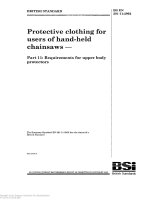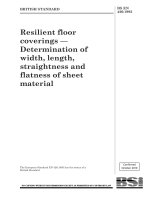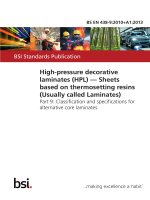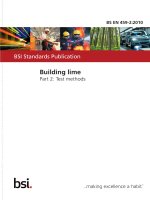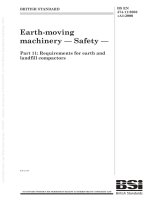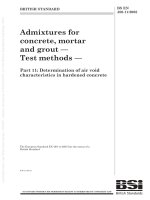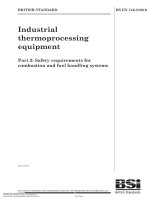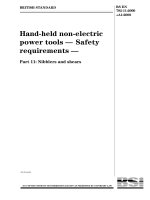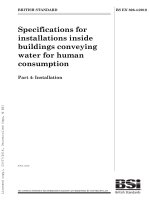Bsi bs en 62058 11 2010
Bạn đang xem bản rút gọn của tài liệu. Xem và tải ngay bản đầy đủ của tài liệu tại đây (1.85 MB, 90 trang )
BS EN 62058-11:2010
BSI Standards Publication
Electricity metering
equipment (a.c.) —
Acceptance inspection
Part 11: General acceptance inspection
methods
NO COPYING WITHOUT BSI PERMISSION EXCEPT AS PERMITTED BY COPYRIGHT LAW
raising standards worldwide™
BRITISH STANDARD
BS EN 62058-11:2010
National foreword
This British Standard is the UK implementation of EN 62058-11:2010. It was
derived by CENELEC from IEC 62058-11:2008. Together with BS EN 6205821:2010, it supersedes BS EN 60514:1995 which is withdrawn. Together with
BS EN 62058-31:2010, it supersedes BS EN 61358:1996 which is withdrawn.
The CENELEC common modifications have been implemented at the appropriate places in the text and are indicated by tags (e.g. }~ ).
The UK participation in its preparation was entrusted to Technical Committee
PEL/13, Electricity Meters.
A list of organizations represented on this committee can be obtained on
request to its secretary.
This publication does not purport to include all the necessary provisions of a
contract. Users are responsible for its correct application.
© BSI 2010
ISBN 978 0 580 59104 4
ICS 17.220.20; 91.140.50
Compliance with a British Standard cannot confer immunity from
legal obligations.
This British Standard was published under the authority of the Standards
Policy and Strategy Committee on 30 September 2010.
Amendments/corrigenda issued since publication
Date
Text affected
EUROPEAN STANDARD
EN 62058-11
NORME EUROPÉENNE
EUROPÄISCHE NORM
ICS 17.220; 91.140.50
June 2010
Supersedes EN 60514:1995 (partially), EN 61358:1996 (partially)
English version
Electricity metering equipment (a.c.) Acceptance inspection Part 11: General acceptance inspection methods
(IEC 62058-11:2008, modified)
Equipement de comptage
de l'électricité (c.a.) Contrôle de réception Partie 11: Méthodes générales
de contrôle de réception
(CEI 62058-11:2008, modifiée)
Wechselstrom-Elektrizitätszähler Annahmeprüfung Teil 11: Allgemeine Verfahren
zur Annahmeprüfung
(IEC 62058-11:2008, modifiziert)
This European Standard was approved by CENELEC on 2010-06-01. CENELEC members are bound to comply
with the CEN/CENELEC Internal Regulations which stipulate the conditions for giving this European Standard
the status of a national standard without any alteration.
Up-to-date lists and bibliographical references concerning such national standards may be obtained on
application to the Central Secretariat or to any CENELEC member.
This European Standard exists in three official versions (English, French, German). A version in any other
language made by translation under the responsibility of a CENELEC member into its own language and notified
to the Central Secretariat has the same status as the official versions.
CENELEC members are the national electrotechnical committees of Austria, Belgium, Bulgaria, Croatia, Cyprus,
the Czech Republic, Denmark, Estonia, Finland, France, Germany, Greece, Hungary, Iceland, Ireland, Italy,
Latvia, Lithuania, Luxembourg, Malta, the Netherlands, Norway, Poland, Portugal, Romania, Slovakia, Slovenia,
Spain, Sweden, Switzerland and the United Kingdom.
CENELEC
European Committee for Electrotechnical Standardization
Comité Européen de Normalisation Electrotechnique
Europäisches Komitee für Elektrotechnische Normung
Management Centre: Avenue Marnix 17, B - 1000 Brussels
© 2010 CENELEC -
All rights of exploitation in any form and by any means reserved worldwide for CENELEC members.
Ref. No. EN 62058-11:2010 E
BS EN 62058-11:2010
EN 62058-11:2010
–2–
Foreword
The text of document 13/1430/FDIS, future edition 1 of IEC 62058-11, prepared by IEC TC 13, Electrical
energy measurement, tariff- and load control, was submitted to the IEC-CENELEC parallel vote.
A draft amendment, prepared by the Technical Committee CENELEC TC 13, Equipment for electrical
energy measurement and load control, was submitted to the formal vote.
The combined texts were approved by CENELEC as EN 62058-11 on 2010-06-01.
EN 62058-11:2010, together with EN 62058-21:2010, supersedes EN 60514:1995 and, together with
EN 62058-31:2010, EN 62058-11:2010 supersedes EN 61358:1996.
Attention is drawn to the possibility that some of the elements of this document may be the subject of
patent rights. CEN and CENELEC shall not be held responsible for identifying any or all such patent
rights.
The following dates were fixed:
– latest date by which the EN has to be implemented
at national level by publication of an identical
national standard or by endorsement
(dop)
2011-06-01
– latest date by which the national standards conflicting
with the EN have to be withdrawn
(dow)
2013-06-01
This European Standard has been prepared under a mandate given to CENELEC by the European
Commission and the European Free Trade Association and covers essential requirements of
EC Directive 2004/22/EC. See Annex ZZ.
Annexes ZA and ZZ have been added by CENELEC.
__________
Endorsement notice
The text of the International Standard IEC 62058-11:2008 was approved by CENELEC as a European
Standard with agreed common modifications.
BS EN 62058-11:2010
EN 62058-11:2010
–3–
Annex ZA
(normative)
Normative references to international publications
with their corresponding European publications
The following referenced documents are indispensable for the application of this document. For dated
references, only the edition cited applies. For undated references, the latest edition of the referenced
document (including any amendments) applies.
NOTE When an international publication has been modified by common modifications, indicated by (mod), the relevant EN/HD
applies.
Publication
Year
Title
EN/HD
Year
ISO 2859-1
+ corr. March
1999
2001
Sampling procedures for inspection by
attributes Part 1: Sampling schemes indexed by
acceptance quality limit (AQL) for lot-by-lot
inspection
-
-
ISO 2859-2
1985
Sampling procedures for inspection by
attributes Part 2: Sampling plans indexed by limiting
quality (LQ) for isolated lot inspection
-
-
ISO 2859-3
2005
Sampling procedures for inspection by
attributes Part 3: Skip-lot sampling procedures
-
-
ISO 3534-2
2006
Statistics - Vocabulary and symbols Part 2: Applied statistics
-
-
ISO 3951-1
2005
Sampling procedures for inspection by
variables Part 1: Specification for single sampling plans
indexed by acceptance quality limit (AQL) for
lot-by-lot inspection for a single quality
characteristic and a single AQL
-
ISO 3951-2
2006
Sampling procedures for inspection by
variables Part 2: General specification for single
sampling plans indexed by acceptance quality
limit (AQL) for lot-by-lot inspection of
independent quality characteristics
-
ISO 5479
1997
Statistical interpretation of data - Tests for
departure from the normal distribution
-
-
BS EN 62058-11:2010
EN 62058-11:2010
–4–
Annex ZZ
(informative)
Coverage of Essential Requirements of EC Directives
This European Standard has been prepared under the mandate M/374 given to CENELEC by the
European Commission and within its scope, the standard covers methods for statistical verification of
conformity with the metrological requirements in connection the Modules F, D and H1.
EN 62058-11 specifies sampling plans, schemes and systems for lot-by-lot inspection by attributes or
variables. In addition, a test procedure for 100 % inspection is specified, that can be used if the lot size is
too small for sampling inspection or when sampling inspection has to be discontinued.
Table ZZ.1 provides the relationship between the Essential requirements of the MID and the stipulations
of the EN 62058 series.
Compliance with this standard provides one means of conformity with the specified essential
requirements of the Directives concerned.
WARNING: Other requirements and other EC Directives may be applicable to the products falling within
the scope of this standard.
BS EN 62058-11:2010
EN 62058-11:2010
–5–
Table ZZ.1 – Relationship between the Essential requirements of the MID
and the stipulations of the relevant standards
MID Annex I
Subject
EN 62058-11
EN 62058-21
EN 62058-31
–
5.6 Accuracy
tests, Table
Z2
5.7
Verification of
the register
5.6 Accuracy
tests, Table
Z2
5.7
Verification of
the register
NOTE The text in this column is
for orientation. For the full text see
the MID.
1
Allowable Errors
1.1
Under rated operating conditions
and in the absence of disturbance
1.2
Under rated operating conditions
and in the presence of disturbance
–
–
–
1.3
Climatic, mechanical and EM
environment and other influence
quantities to be specified by the
manufacturer
–
–
–
1.3.1
Climatic environments, upper and
lower temperature limit
–
–
–
1.3.2
Mechanical environments,
vibration and shock
–
–
–
1.3.3
Electromagnetic environments,
unless otherwise laid down in the
appropriate instrument-specific
annexes.
–
–
–
1.3.4
Other influence quantities
–
–
–
1.4
Carrying out the tests
–
–
–
1.4.1
Basic rules for testing and
determination of errors
–
5.6,
Accuracy test
5.6,
Accuracy test
1.4.2
Ambient humidity
–
–
–
2
Reproducibility
–
–
–
3
Repeatability
–
4.3
4.3
4
Discrimination and Sensitivity
–
–
–
5
Durability
–
–
–
6
Reliability
–
–
–
7
Suitability
5.3
AC voltage
test
5.3
AC voltage
test
7.1
7.2
No feature likely to facilitate
fraudulent use, possibilities for
unintentional misuse minimal
–
–
–
Suitable for intended use under
practical working conditions, no
unreasonable demand of the user
–
–
–
BS EN 62058-11:2010
EN 62058-11:2010
MID Annex I
7.3
7.4
7.5
7.6
8
8.1
8.2
8.3
–6–
Subject
EN 62058-11
EN 62058-21
EN 62058-31
–
–
–
N.A.
N.A.
N.A.
Robust and materials of
construction suitable for the
intended use conditions.
–
–
–
Designed so as to allow the control
of the measuring tasks after the
instrument has been placed on the
market and put into use.
Software that is critical for the
metrological characteristics
identifiable.
Metrological characteristics not
inadmissibly influenced by the
associated software.
–
–
–
Protection against corruption
–
–
–
Metrological characteristics not
influenced in any inadmissible way
by the connection to it of another
device, by any feature of the
connected device itself or by any
remote device that communicates
with the measuring instrument.
–
–
–
Hardware component critical for
metrological characteristics
designed so that it can be secured.
Security measures to provide
evidence of an intervention.
–
–
–
–
–
–
Measurement data, critical software and
metrologically important parameters
stored
or
transmitted
adequately
protected
against
accidental
or
intentional corruption.
–
–
–
For utility measuring instruments the
display of the total quantity supplied or
the displays from which the total quantity
supplied can be derived, whole or partial
reference to which is the basis for
payment, shall not be able to be reset
during use.
–
–
–
Errors of a utility measuring
instrument at flows or currents
outside the controlled range not
unduly biased.
When the measurand is constant
over time, the measuring
instrument shall be insensitive to
small fluctuations of the value of
the measurand, or shall take
appropriate action.
Software that is critical for metrological
characteristics shall be identified as such
and shall be secured.
Software identification.
Evidence of an intervention available for
a reasonable period of time.
8.4
8.5
BS EN 62058-11:2010
EN 62058-11:2010
–7–
MID Annex I
9
9.1
Subject
EN 62058-11
EN 62058-21
EN 62058-31
Information to be borne by and to
accompany the instrument
–
–
–
–
5.2
5.2
N.A.
N.A.
N.A.
–
–
–
Shall bear the following
inscriptions:
- manufacturers mark or name;
- information in respect of
accuracy.
When applicable:
-
-
9.2
9.3
information in respect of the
conditions of use;
measuring capacity;
measuring range;
identity marking;
number of the EC-type examination
certificate or the EC design
examination certificate;
information whether or not additional
devices providing metrological
results comply with the provisions of
this Directive on legal metrological
control.
For too small instruments, marking
on packaging and in any
accompanying documents
Accompanying information on
- operation
and where relevant
- rated operating conditions;
- mechanical and
electromagnetic environment
classes;
the upper and lower
temperature limit, whether
condensation is possible or
not, open or closed location;
- instructions for installation,
maintenance, repairs,
permissible adjustments;
- instructions for correct
operation and any special
conditions of use;
- conditions for compatibility with
interfaces, sub-assemblies or
measuring instruments.
9.4
Utility meters do not require
individual instruction manuals.
–
–
–
9.5
Decimal scale interval
–
–
–
9.6
Material measure
N.A.
N.A.
N.A.
9.7
Units of measurement and
symbols in accordance with
Community legislation
–
–
–
Marks and inscriptions clear, nonerasable, unambiguous and nontransferable.
–
–
–
9.8
BS EN 62058-11:2010
EN 62058-11:2010
MID Annex I
10
–8–
Subject
Indication of result
EN 62058-11
EN 62058-21
EN 62058-31
–
–
–
10.1
Display or hard copy
N.A.
N.A.
N.A.
10.2
Indication of result clear and
unambiguous. Easy reading.
N.A.
N.A.
N.A.
10.3
Hard copy easily legible and not
erasable
N.A.
N.A.
N.A.
10.4
Direct sales trading transactions
N.A.
N.A.
N.A.
10.5
Fitted with a metrologically controlled
display accessible without tools to the
consumer.
5.7
Verification of
the register
5.7
Verification of
the register
5.7
Verification of
the register
Further processing of data to
conclude the trading transaction
N.A.
N.A.
N.A.
Durable record of the
measurement result (other than
utility meter)
N.A.
N.A.
N.A.
Durable proof of the measurement
result
N.A.
N.A.
N.A.
–
–
–
The reading of this display is the
measurement result that serves as the
basis for the price to pay.
11
11.1
11.2
12
Conformity evaluation
Designed so as to allow ready
evaluation of its conformity with
the appropriate requirements of
this Directive.
Annex MI003
ACTIVE ELECTRICAL ENERGY
METERS
1
Accuracy
–
–
–
2
Rated operating conditions
–
–
–
3
MPEs
5.6 Accuracy
tests, Table
Z2
5.7
Verification of
the register
5.6 Accuracy
tests, Table
Z2
5.7
Verification of
the register
4
Permissible effect of disturbances
–
–
–
4.1
General – Special EM environment
–
–
–
4.2
Effect of disturbances of long
duration
–
–
–
Reversed phase sequence
–
–
–
Voltage unbalance (only applicable to
polyphase meters)
–
–
–
Harmonic contents in the current circuits
–
–
–
DC and harmonics in the current circuit
–
–
–
Fast transient bursts
–
–
–
BS EN 62058-11:2010
EN 62058-11:2010
–9–
MID Annex I
EN 62058-11
EN 62058-21
EN 62058-31
Magnetic fields
–
–
–
HF (radiated RF) electromagnetic field;
–
–
–
Conducted disturbances
introduced by radio-frequency
fields
–
–
–
Oscillatory waves immunity
–
–
–
4.3
Permissible effect of transient
electromagnetic phenomena
–
–
–
4.3.1
Behavior during and immediately
after a disturbance
Recovery
Critical change value
–
–
–
Critical change value for
overcurrent
–
–
–
4.3.2
5
Subject
Suitability
5.1
Measurement error below the rated
operating voltage
–
–
–
5.2
Display of total energy
- sufficient number of digits
- not resettable during use
–
–
–
5.3
Retain energy register reading for
4 months
–
–
–
5.4
Running with no load
5.5
Starting
–
5.4 Test of
no-load
condition
5.4 Test of
no-load
condition
–
5.5 Starting,
Table Z1
5.5 Starting,
Table Z1
6
Units
–
–
–
7
Putting into use
–
–
–
Specifies
100% testing
and sampling
inspection
methods to
support
modules F, D
and H1
–
–
CONFORMITY ASSESSMENT
B + F or B + D or H1.
BS EN 62058-11:2010
EN 62058-11:2010
– 10 –
CONTENTS
INTRODUCTION................................................................................................................... 14
1
Scope ............................................................................................................................. 15
2
Normative references ..................................................................................................... 15
3
Terms and definitions ..................................................................................................... 15
4
3.1 Sources of data ..................................................................................................... 16
3.2 Types of sampling ................................................................................................. 17
3.3 Specifications, values and test results ................................................................... 17
3.4 Types of inspection ............................................................................................... 18
3.5 Types of acceptance sampling inspection.............................................................. 20
3.6 Acceptance sampling inspection system aspects ................................................... 21
3.7 Acceptance criteria................................................................................................ 22
3.8 Types of operating characteristic curves................................................................ 24
3.9 Terms relating to operating characteristics ............................................................ 24
3.10 Outgoing quality concepts ..................................................................................... 27
3.11 Other terms ........................................................................................................... 27
Symbols and abbreviations ............................................................................................. 28
5
4.1 Symbols ................................................................................................................ 28
4.2 Acronyms .............................................................................................................. 29
General .......................................................................................................................... 29
5.1
5.2
5.3
5.4
5.5
5.6
6
The objectives of acceptance inspection ............................................................... 29
Acceptance sampling plans, schemes and systems ............................................... 30
Practical and economic advantages of using standard sampling plans .................. 30
Agreement between the parties ............................................................................. 31
Selection of sampling schemes and sampling plans .............................................. 32
Considerations influencing a selection................................................................... 33
5.6.1 Long and short production runs ................................................................. 33
5.6.2 Lot-by-lot inspection .................................................................................. 34
5.6.3 Isolated lot inspection ................................................................................ 34
5.6.4 Attributes versus variables ........................................................................ 34
5.6.5 Single and double sampling ....................................................................... 35
5.6.6 “s” method and “ σ ” method......................................................................... 35
5.7 Nonconformity and nonconforming items ............................................................... 35
5.8 Classification of nonconformities ........................................................................... 35
5.9 Operating characteristic (OC) curve ...................................................................... 36
5.10 Producer’s risks (PR) and consumer’s risk (CR) .................................................... 36
5.11 AQL, PRQ, LQ and CRQ ....................................................................................... 37
5.12 Switching rules for normal, tightened and reduced inspection ................................ 37
5.13 Inspection level ..................................................................................................... 38
5.14 Sample size code letter ......................................................................................... 38
5.15 Place of inspection ................................................................................................ 39
5.16 Submission of product for acceptance inspection .................................................. 39
5.17 Drawing of samples ............................................................................................... 39
5.18 Acceptability of lots ............................................................................................... 40
100 % inspection ............................................................................................................ 40
6.1
Application of the method ...................................................................................... 40
– 11 –
7
BS EN 62058-11:2010
EN 62058-11:2010
6.2 Lot sizes and acceptance numbers ........................................................................ 40
6.3 Acceptance and non-acceptance ........................................................................... 41
Lot-by-lot inspection by attributes ................................................................................... 41
Application of the method ...................................................................................... 41
Drawing of samples ............................................................................................... 42
Inspection level ..................................................................................................... 42
Sampling plans...................................................................................................... 42
7.4.1 Obtaining a sampling plan ......................................................................... 42
7.4.2 Single sampling plans................................................................................ 42
7.4.3 Double sampling plans .............................................................................. 45
7.4.4 Determination of acceptability.................................................................... 46
7.5 Normal, tightened and reduced inspection (see also 5.12) ..................................... 47
7.5.1 Start and continuation of inspection ........................................................... 47
7.5.2 Normal to tightened ................................................................................... 47
7.5.3 Tightened to normal................................................................................... 48
7.5.4 Normal to reduced ..................................................................................... 48
7.5.5 Reduced to normal .................................................................................... 49
7.5.6 Discontinuation and resumption of inspection ............................................ 49
7.6 Operating characteristic (OC) curves ..................................................................... 49
7.7 Process average ................................................................................................... 52
7.8 Average outgoing quality (AOQ) ............................................................................ 52
7.9 Average outgoing quality limit (AOQL) ................................................................... 52
7.10 Consumer’s risk (CR) ............................................................................................ 53
7.11 Producer’s risk (PR) .............................................................................................. 55
Isolated lot inspection..................................................................................................... 56
7.1
7.2
7.3
7.4
8
8.1
8.2
9
Application of the method ...................................................................................... 56
Procedures specified ............................................................................................. 56
8.2.1 Procedure A .............................................................................................. 56
8.2.2 Procedure B .............................................................................................. 56
8.3 Limiting quality ...................................................................................................... 56
8.4 Procedure A .......................................................................................................... 56
8.5 Procedure B .......................................................................................................... 59
8.6 Rules for acceptance and non-acceptance ............................................................ 61
Skip-lot inspection .......................................................................................................... 61
9.1 Application of the method ...................................................................................... 61
9.2 Manufacturer qualification ..................................................................................... 62
9.3 Product qualification .............................................................................................. 62
9.4 Detailed procedures .............................................................................................. 63
10 Lot-by-lot inspection by variables ................................................................................... 63
10.1 Application of the method ...................................................................................... 63
10.2
10.3
10.4
10.5
Choice between the “s” and the “ σ ” methods.......................................................... 63
Standard plans ...................................................................................................... 64
Preliminary operations........................................................................................... 64
Standard multivariate “s” method procedures for independent quality
characteristics with combined control .................................................................... 64
10.5.1 General methodology ................................................................................ 64
10.5.2 Sampling plans .......................................................................................... 65
10.5.3 Description of the procedure...................................................................... 66
10.5.4 Simplified exact formula for the “s” method with sample size 4 .................. 67
BS EN 62058-11:2010
EN 62058-11:2010
– 12 –
10.5.5 Approximate procedure for the “s” method for n > 5 ................................... 67
10.6 Standard multivariate “ σ ” method procedures for independent quality
characteristics with combined control .................................................................... 70
10.6.1 General methodology ................................................................................ 70
10.6.2 Sampling plans .......................................................................................... 71
10.6.3 Description of the procedure...................................................................... 71
10.7 Procedure during continuing inspection ................................................................. 72
10.8 Normality and outliers............................................................................................ 72
10.8.1 Normality ................................................................................................... 72
10.8.2 Outliers ..................................................................................................... 72
10.9 Records ................................................................................................................ 72
10.9.1 Control charts ............................................................................................ 72
10.9.2 Lots that are not accepted ......................................................................... 72
10.10 Normal, tightened and reduced inspection (see also 5.12) .................................. 72
10.11 Discontinuation and resumption of inspection ..................................................... 73
10.12 Switching between the “s” and “σ” methods ......................................................... 74
10.12.1 Estimating the process standard deviation .............................................. 74
10.12.2 State of statistical control ........................................................................ 74
10.12.3 Switching from the “s” method to the “σ” method ...................................... 74
10.12.4 Switching from the “σ” method to the “s” method ...................................... 75
10.13 Consumer protection .......................................................................................... 75
10.14 Operating characteristic curves .......................................................................... 75
10.15 Consumer’s risk (CR) ......................................................................................... 78
10.16 Producer’ risk (PR) ............................................................................................. 80
Annex A (normative) Random numbers ................................................................................ 82
Annex B (normative) Procedure for obtaining s or σ ............................................................. 85
Bibliography.......................................................................................................................... 86
Figure 1 – Selection procedure of sampling schemes and plans ........................................... 33
Figure 2 – Outline of switching rules ..................................................................................... 38
Figure 3 – OC curves for AQL = 1,0, single sampling plans, normal inspection ..................... 50
Figure 4 – OC curves for AQL = 1,0, single sampling plans, tightened inspection ................. 50
Figure 5 – OC curves for single sampling plans, Ac=0 .......................................................... 51
Figure 6 – Operating characteristic curves for single sampling plans for non-critical
nonconformities, procedure B ............................................................................................... 60
Figure 7 – OC curves for normal inspection, AQL = 1,0......................................................... 75
Figure 8 – OC curves for tightened inspection, AQL = 1,0 ..................................................... 76
Figure 9 – OC curves for reduced inspection, AQL = 1,0....................................................... 77
Table 1 – Acceptance number Ac for 100 % inspection ......................................................... 40
Table 2 – Single sampling plans for normal, tightened and reduced inspection, AQL = 1,0... 43
Table 3 – Example with lot size = 80, inspection level II ........................................................ 43
Table 4 – Example with lot size = 400, inspection level II ...................................................... 44
Table 5 – Example with lot size = 800, inspection level III ..................................................... 44
Table 6 – Single sampling plans for critical nonconformities Ac = 0....................................... 45
Table 7 – Double sampling plans for normal, tightened and reduced inspection, AQL = 1,0 . 46
– 13 –
BS EN 62058-11:2010
EN 62058-11:2010
Table 8 – Calculation of switching scores ............................................................................. 49
Table 9 – Tabulated values of OC curves for single sampling, AQL = 1,0 plans .................... 51
Table 10 – Tabulated values of OC curves for single sampling, normal inspection,
accept zero sampling plans................................................................................................... 52
Table 11 – Average Outgoing Quality Limit (AOQL) at AQL = 1,0.......................................... 53
Table 12 – Average Outgoing Quality Limit (AOQL) for Ac = 0 sampling plans, normal
inspection ............................................................................................................................. 53
Table 13 – Consumer’s risk quality (CRQ): AQL = 1,0 plans .................................................5 4
Table 14 – Consumer’s risk quality (CRQ): Accept zero plans............................................... 54
Table 15 – Producer’s risk (PR): AQL = 1,0 .......................................................................... 55
Table 16 – Producer’s risk (PR): Accept zero plans .............................................................. 55
Table 17 – Sampling plans for non-critical nonconformities, procedure A, LQ = 5,0 ............. 57
Table 18 – Sampling plans for critical nonconformities, procedure A ..................................... 58
Table 19 – Probability of acceptance for accept zero plans ................................................... 58
Table 20 – Single sampling plans for non-critical nonconformities, procedure B, LQ = 5,0 .... 60
Table 21 – Equivalent sample sizes for single and double sampling...................................... 61
Table 22 – Equivalent acceptance numbers for single and double sampling.......................... 61
Table 23 – Sample sizes for the “s” method and the “ σ ” method with AQL = 1,0 .................... 64
Table 24 – Sampling plans for the “s” method ....................................................................... 66
Table 25 – Values of a n ......................................................................................................... 68
Table 26 – Sampling plans for the “ σ ” method ....................................................................... 71
Table 27 – Supplementary acceptability constants for qualifying towards reduced
inspection ............................................................................................................................. 73
Table 28 – Values of c U for upper control limit on the sample standard deviation .................. 74
Table 29 – Tabulated values of OC curves for normal inspection, AQL = 1,0 ........................ 76
Table 30 – Tabulated values of OC curves for tightened inspection, AQL = 1,0..................... 77
Table 31 – Tabulated values of OC curves for reduced inspection, AQL = 1,0....................... 78
Table 32 – Consumer’s risk quality (CRQ): “s” method .......................................................... 79
Table 33 – Consumer’s risk quality (CRQ): “ σ ” method ......................................................... 79
Table 34 – Producer’s risk (PR): “s” method .......................................................................... 80
Table 35 – Producer’s risk (PR): “ σ ” method ......................................................................... 80
Table A.1 – Random numbers ............................................................................................... 82
BS EN 62058-11:2010
EN 62058-11:2010
– 14 –
INTRODUCTION
This part of IEC 62058 describes – based on relevant standards established by ISO TC 69
SC 5 – general acceptance inspection methods of newly manufactured electricity meters,
supplied in lots of 50 and above. The method of acceptance of smaller lots should be agreed
upon by the manufacturer and the customer.
In this standard, it has been taken into account that modern, automated manufacturing
processes operated under quality management systems allow to keep the quality level under
tight control.
This standard, together with IEC 62058-21, containing particular requirements for acceptance
inspection of electromechanical meters for active energy, and IEC 62058-31, containing
particular requirements for acceptance inspection of static meters for active energy, cancels
and replaces the following standards:
•
IEC 60514: Acceptance inspection of class 2 alternating-current watt-hour meters and
•
IEC 61358: Acceptance inspection for direct connected alternating current static watt-hour
meters for active energy (classes 1 and 2).
Main changes in this standard compared to those earlier standards:
•
it is based on the latest standards established by ISO TC 69 SC 5;
•
the rules for switching between normal, tightened and reduced inspection have been
adopted;
•
the procedures for inspection of isolated lots have been adopted;
•
the procedures for skip-lot sampling have been adopted;
•
for inspection by variables, the “R” method has been eliminated and the “ σ ” method has
been adopted.
– 15 –
BS EN 62058-11:2010
EN 62058-11:2010
ELECTRICITY METERING EQUIPMENT (a.c.) –
ACCEPTANCE INSPECTION –
Part 11: General acceptance inspection methods
1
Scope
The general acceptance inspection methods specified in this part of IEC 62058 apply to newly
manufactured electricity meters produced and supplied in lots of 50 and above.
} The process described herein can be used for assessment of conformity with the requirements of the
Directive 2004/22/EC of the European Parliament and of the Council on measuring instruments (MID),
using:
- Module D, Declaration of conformity to type based on quality assurance of the production process:
-
-
Final product inspection and testing;
Module F, Declaration of conformity to type based on product verification:
-
Verification of conformity with the metrological requirements by examination and testing of every
instrument; or
-
Statistical verification of conformity with the metrological requirements;
Module H1, Declaration of conformity based on full quality assurance plus design examination:
- Final product inspection and testing.
When the process is used within module F, the inspection methods selected shall meet the requirements
specified in 5.3 of Annex F of the MID. See 5.5 below.
It is noted, that the requirements of 5.3 of Annex F of the MID do not take into account the switching rules
between normal, tightened and reduced inspection. Those switching rules, mandatory with lot-by-lot
inspection, when properly applied, ensure adequate protection to the customer against poor quality, and
provide incentives to the manufacturer to produce consistently good quality.~
2
Normative references
The following referenced documents are indispensable for the application of this document.
For dated references, only the edition cited applies. For undated references, the latest edition
of the referenced document (including any amendments) applies.
ISO 2859-1:1999, Sampling procedures for inspection by attributes – Part 1: Sampling
schemes indexed by acceptance quality limit (AQL) for lot-by-lot inspection
ISO 2859-1:1999/Cor 1:2001
ISO 2859-2:1985, Sampling procedures for inspection by attributes – Part 2: Sampling plans
indexed by limiting quality (LQ) for isolated lot inspection
ISO 2859-3:2005, Sampling procedures for inspection by attributes – Part 3: Skip-lot sampling
procedures
ISO 3534-2:2006 Ed. 2 Statistics – Vocabulary and symbols – Part 2: Applied statistics
ISO 3951-1:2005 Ed. 1, Sampling procedures for inspection by variables – Part 1:
Specification for single sampling plans indexed by acceptance quality limit (AQL) for lot-by-lot
inspection for a single quality characteristic and a single AQL
ISO 3951-2:2006 Ed. 1, Sampling procedures for inspection by variables – Part 2: General
specification for single sampling plans indexed by acceptance quality limit (AQL) for lot-by-lot
inspection of independent quality characteristics
ISO 5479:1997, Statistical interpretation of data – Tests for departure from the normal
distribution
3
Terms and definitions
For the purposes of this document, the terms and definitions of ISO 3534-2 and the following
apply.
NOTE In this standard, the term “meter” means any kind of metering equipment in the Scope of TC 13, i.e. meters
for active or reactive energy, time switches, ripple control receivers, etc. The term “customer” is used with the
same meaning as “consumer” and the term “manufacturer” is used with the same meaning as the term “supplier”.
BS EN 62058-11:2010
EN 62058-11:2010
3.1
– 16 –
Sources of data
3.1.1
characteristic
distinguishing feature
NOTE 1
A characteristic can be inherent or assigned.
NOTE 2
A characteristic can be qualitative or quantitative.
[ISO 3534-2, 1.1.1 modified]
3.1.2
population
(reference) totality of items under consideration
[ISO 3534-2, 1.2.1. modified]
3.1.3
lot
definite part of a population constituted under essentially the same conditions as the
population with respect to the sampling purpose
NOTE The sampling purpose can, for example, be to determine lot acceptability, or to estimate the mean value of
a particular characteristic.
[ISO 3534-2, 1.2.4]
3.1.4
isolated lot
lot separated from the sequence of lots in which it was formed and not forming part of a
current sequence
[ISO 3534-2, 1.2.5]
3.1.5
re-submitted lot
lot which previously has been designated as not acceptable and which is submitted again for
inspection after having been further treated, tested, sorted, reprocessed, etc.
[ISO 3534-2, 1.2.9]
3.1.6
item
entity
anything that can be described and considered separately; for the purposes of this standard,
an electricity meter
[ISO 3534-2, 1.2.11 modified]
3.1.7
nonconforming item
item with one or more nonconformities
[ISO 3534-2, 1.2.12]
3.1.8
defective item
item with one or more defects
[ISO 3534-2, 1.2.13]
– 17 –
BS EN 62058-11:2010
EN 62058-11:2010
3.1.9
sampling unit
unit
one of the individual parts into which a population is divided
[ISO 3534-2, 1.2.14 modified]
3.1.10
nonconforming unit
unit with one or more nonconformities
[ISO 3534-2, 1.2.15]
3.1.11
sample
subset of a population made up of one or more sampling units
[ISO 3534-2, 1.2.17 modified]
3.1.12
sample size
number of sampling units in a sample
NOTE In a multistage sample, the sample size is the total number of sampling units at the conclusion of the final
stage of sampling.
[ISO 3534-2, 1.2.26]
3.2
Types of sampling
3.2.1
sampling
act of drawing or constituting a sample
[ISO 3534-2, 1.3.1]
3.2.2
simple random sampling
sampling where a sample of n sampling units is taken from a population in such a way that all
the possible combinations of n sampling units have the same probability of being taken
[ISO 3534-2, 1.3.4 modified]
3.2.3
acceptance sampling
sampling after which decisions are made to accept or not to accept a lot based on sample
results
[ISO 3534-2, 1.3.17 modified]
3.3
Specifications, values and test results
3.3.1
specification limit
limiting value stated for a characteristic
[ISO 3534-2, 3.1.3]
BS EN 62058-11:2010
EN 62058-11:2010
– 18 –
3.3.2
upper specification limit
U
specification limit that defines the upper limiting value
[ISO 3534-2, 3.1.4]
3.3.3
lower specification limit
L
specification limit that defines the lower limiting value
[ISO 3534-2, 3.1.5]
3.3.4
single specification limit
specification limit where the decision criteria is applied only to one limit
[ISO 3534-2, 3.1.7]
3.3.5
combined double specification limit
specification limit where the decision criteria is applied collectively to the upper and lower
limits
[ISO 3534-2, 3.1.8]
3.3.6
combined control
requirement when nonconformity beyond both the upper and the lower specification of a
quality characteristic belongs to the same class, to which a single AQL is applied
[ISO 3951-2, 3.17, modified]
3.3.7
nonconformity
non-fulfilment of a requirement
NOTE
See notes to “defect”.
[ISO 3534-2, 3.1.11]
3.3.8
defect
non-fulfilment of a requirement related to an intended or specified use
NOTE 1 The distinction between the concepts defect and nonconformity is important as it has legal connotations,
particularly those associated with product liability issues. Consequently, the term “defect” should be used with
extreme caution.
NOTE 2 The intended use by the customer can be affected by the nature of the information, such as operating or
maintenance instructions, provided by the customer.
[ISO 3534-2, 3.1.12]
3.4
Types of inspection
3.4.1
conformity evaluation
systematic examination of the extent to which an item/entity fulfils specified requirements
[ISO 3534-2, 4.1.1]
– 19 –
BS EN 62058-11:2010
EN 62058-11:2010
3.4.2
inspection
conformity evaluation by observation and judgement accompanied as appropriate by
measurement, testing or gauging
[ISO 3534-2, 4.1.2]
3.4.3
inspection by attributes
inspection by noting the presence, or absence, of one or more particular characteristic(s) in
each of the items in the group under consideration, and counting how many items do, or do
not, possess the characteristic(s), or how many such events occur in the item
NOTE When inspection is performed by simply noting whether the item is nonconforming or not, the inspection is
termed inspection for nonconforming items. When inspection is performed by noting the number of nonconformities
on each unit, the inspection is termed inspection for number of nonconformities.
[ISO 3534-2, 4.1.3 modified]
3.4.4
inspection by variables
inspection by measuring the magnitude(s) of the characteristic(s) of an item
[ISO 3534-2, 4.1.4]
3.4.5
100 % inspection
inspection of selected characteristic(s) of every item in the group under consideration
[ISO 3534-2, 4.1.5]
3.4.6
sampling inspection
inspection of selected items in the group under consideration
[ISO 3534-2, 4.1.6]
3.4.7
acceptance sampling inspection
acceptance inspection where the acceptability is determined by means of sampling inspection
[ISO 3534-2, 4.1.8]
3.4.8
normal inspection
inspection which is used when there is no reason to think that the quality level achieved by
the process differs from a specified level
[ISO 3534-2, 4.1.10]
3.4.9
reduced inspection
inspection less severe than normal inspection, to which the latter is switched when inspection
results of a predetermined number of lots indicate that the quality level achieved by the
process is better than that specified
[ISO 3534-2, 4.1.11]
BS EN 62058-11:2010
EN 62058-11:2010
– 20 –
3.4.10
switching score
indicator that is used under normal inspection to determine whether the current inspection
results are sufficient to allow for a switch to reduced inspection
[ISO 2859-1, 3.1.23]
3.4.11
tightened inspection
inspection more severe than normal inspection, to which the latter is switched when
inspection results of a predetermined number of lots indicate that the quality level achieved by
the process is poorer than that specified
[ISO 3534-2, 4.1.12]
3.4.12
isolated lot inspection
inspection of a unique lot or one separated from the sequence of lots in which it was produced
or collected
[ISO 3534-2, 4.1.14]
3.4.13
lot-by-lot inspection
inspection of a product submitted in a series of lots
[ISO 3534-2, 4.1.15]
3.4.14
original inspection
inspection of a lot, or other amount, not previously inspected
NOTE This is in contrast, for example, to inspection of a lot which has previously been designated as not
acceptable and which is submitted again for inspection after having been further sorted, reprocessed, etc.
[ISO 3534-2, 4.1.16]
3.4.15
acceptance inspection
inspection to determine whether a lot or other amount is acceptable
[ISO 3534-2, 4.1.17]
3.5
Types of acceptance sampling inspection
3.5.1
single acceptance sampling inspection
acceptance sampling inspection in which the decision, according to a defined rule, is based
on the inspection results obtained from a single sample of predetermined size, n
[ISO 3534-2, 4.2.2]
3.5.2
double acceptance sampling inspection
multiple acceptance sampling inspection in which at most two samples are taken
NOTE
The decisions are made according to defined rules.
[ISO 3534-2, 4.2.3]
– 21 –
BS EN 62058-11:2010
EN 62058-11:2010
3.5.3
skip-lot acceptance sampling inspection
acceptance sampling inspection in which some lots in a series are accepted without
inspection, when the sampling results for a stated number of immediately preceding lots meet
stated criteria
[ISO 3534-2, 4.2.5]
3.5.4
acceptance sampling inspection by variables
acceptance sampling inspection in which the acceptability of a process is determined
statistically from measurements on specified quality characteristics of each item in a sample
from a lot
NOTE
Lots taken from an acceptable process are assumed to be acceptable.
[ISO 3534-2, 4.2.11]
3.5.5
acceptance sampling inspection by attributes
acceptance sampling inspection whereby the presence or absence of one or more specified
characteristics of each item in a sample is observed to establish statistically the acceptability
of a lot or process
[ISO 3534-2, 4.2.12]
3.6
Acceptance sampling inspection system aspects
3.6.1
acceptance sampling inspection system
collection of acceptance sampling plans or acceptance sampling schemes together with
criteria by which appropriate plans or schemes may be chosen
[ISO 3534-2, 4.3.1]
3.6.2
acceptance sampling scheme
combination of acceptance sampling plans with switching rules for changing from one plan to
another
[ISO 3534-2, 4.3.2]
3.6.3
acceptance sampling plan
plan which states the sample size(s) to be used and the associated criteria for lot acceptance
[ISO 3534-2, 4.3.3]
3.6.4
switching rule
instruction within an acceptance sampling scheme for changing from one acceptance
sampling plan to another of greater or lesser severity of sampling based on demonstrated
quality history
NOTE Normal, tightened, reduced inspection or discontinuation of inspection are examples of severity of
sampling.
[ISO 3534-2, 4.3.4]
BS EN 62058-11:2010
EN 62058-11:2010
– 22 –
3.6.5
inspection level
index of the relative amount of inspection of an acceptance sampling scheme, chosen in
advance, and relating the sample size to the lot size
NOTE 1 A lower/higher inspection level can be selected if experience shows that a less/more discriminating
operating characteristic curve will be appropriate.
NOTE 2 The term should not be confused with severity of sampling which concerns switching rules, which operate
automatically.
[ISO 3534-2, 4.3.5]
3.6.6
severity of sampling
degree of discrimination within an acceptance sampling scheme for changing from a normal to
a reduced/tightened acceptance sampling plan if the quality of the submitted product or
service improves/deteriorates
NOTE The term should not be confused with inspection level (4.3.5) which is independent of switching rules
(4.3.4).
[ISO 3534-2, 4.3.6]
3.6.7
acceptance sampling procedure
operational requirements and/or instructions related to the use of a particular acceptance
sampling plan
NOTE This covers the planned method of selection, withdrawal and preparation of sample(s) from a lot to yield
knowledge of the characteristic(s) of the lot.
[ISO 3534-2, 4.3.7]
3.6.8
curtailed inspection
acceptance sampling procedure which contains a provision for stopping inspection when it
becomes apparent that adequate data have been collected for a decision
[ISO 3534-2, 4.3.8]
3.6.9
sigma method
acceptance sampling inspection by variables using the presumed value of the process
standard deviation
[ISO 3534-2, 4.3.9]
3.6.10
s method
acceptance sampling inspection by variables using the sample standard deviation
[ISO 3534-2, 4.3.10]
3.7
Acceptance criteria
3.7.1
rejection number
Re
smallest number of nonconformities or nonconforming items found in the sample by
acceptance sampling by attributes that requires the lot to be not accepted, as given in the
acceptance sampling plan
– 23 –
BS EN 62058-11:2010
EN 62058-11:2010
[ISO 3534-2, 4.4.1]
3.7.2
acceptance number
Ac
largest number of nonconformities or nonconforming items found in the sample by acceptance
sampling by attributes that permits the acceptance of the lot, as given in the acceptance
sampling plan
[ISO 3534-2, 4.4.2]
3.7.3
acceptability constant
k
constant depending on the specified value of the acceptance quality limit and the sample size
used in the criteria for accepting the lot in an acceptance sampling plan by variables
NOTE Other acceptability constants are p * and M , where p * is the maximum acceptable estimate of the process
fraction nonconforming. M (= 100 p *) is an alternative notation in use.
[ISO 3534-2, 4.4.4]
3.7.4
maximum sample standard deviation
MSSD
largest sample standard deviation for a given sample size code letter and acceptance quality
limit for which it is possible to satisfy the acceptance criterion for a double specification limit
when the process variability is unknown
NOTE The MSSD depends on whether the double specification limits are combined, separate or complex and on
the inspection severity (i.e. normal, tightened or reduced).
[ISO 3534-2, 4.4.7]
3.7.5
maximum process standard deviation
MPSD
largest process standard deviation for a given sample size code letter and AQL for which it is
possible to satisfy the acceptance criterion for a double specification limit under all inspection
severities (i.e. normal, tightened and reduced) when the process variability is known
NOTE The MPSD depends on whether the double specification limits are combined, separate or complex, but
does not depend on the inspection severity.
[ISO 3534-2, 4.4.8]
3.7.6
quality statistic
Q
function of the specification limit, the sample mean and the sample or process standard
deviation, used in assessing the acceptability of a lot
NOTE For the case of a single specification limit, the lot may be sentenced on the result of comparing quality
characteristic, Q, with the acceptability constant, k
[ISO 3534-2, 4.4.9]
3.7.7
upper quality statistic
QU
function of the upper specification limit, the sample mean, and the sample or process
standard deviation
